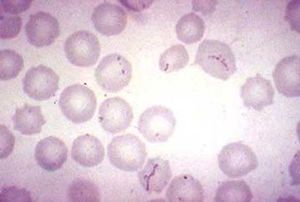Haemobartonella felis: Difference between revisions
Maggiebenson (talk | contribs) |
Maggiebenson (talk | contribs) |
||
| Line 23: | Line 23: | ||
==References== | ==References== | ||
[[http://www.ncbi.nlm.nih.gov/pmc/articles/PMC3133020/?tool=pubmed] Barker, E.N. et al. (2011). Complete genome sequence of Mycoplasma haemofelis, a Hemotropic Mycoplasma. J. Bacteriol, 193.8, 2060-2061 | [[http://www.ncbi.nlm.nih.gov/pmc/articles/PMC3133020/?tool=pubmed]Barker, E.N. et al. (2011). Complete genome sequence of Mycoplasma haemofelis, a Hemotropic Mycoplasma. J. Bacteriol, 193.8, 2060-2061. ] | ||
Edited by Maggie Benson, students of [mailto:glim@rmc.edu Grace Lim-Fong] | Edited by Maggie Benson, students of [mailto:glim@rmc.edu Grace Lim-Fong] | ||
Revision as of 15:40, 18 November 2011
Characteristics of the symbiont/pathogen
What kind of microbe is it (eg Cell morphology, shape, phylogenetic classification)? Is its genome sequenced, and if so, how big is the genome?
The name of the microbe Haemobartonella felis has been recently renamed to Mycoplasma haemofelis due to it having a closer relation to the genus Mycoplasma rather than the genus Bartonella (8).

Characteristics of the host
What host/s is/are involved? Is there host specificity? Are there secondary reservoirs?
Host-Symbiont Interaction
What kind of interaction do host and symbiont have? How is the host affected by the relationship? How does the host acquire and transmit the symbiont? Is the interaction obligate or facultative?
Molecular Insights into the Symbiosis
Describe molecular/genetic studies on the symbiosis.
Ecological and Evolutionary Aspects
What is the evolutionary history of the interaction? Do particular environmental factors play a role in regulating the symbiosis?
Recent Discoveries
Describe two findings on the symbiosis published within the last two years.
References
[[2]Barker, E.N. et al. (2011). Complete genome sequence of Mycoplasma haemofelis, a Hemotropic Mycoplasma. J. Bacteriol, 193.8, 2060-2061. ]
Edited by Maggie Benson, students of Grace Lim-Fong
This template is just a general guideline of how to design your site. You are not restricted to this format, so feel free to make changes to the headings and subheadings and to add or remove sections as appropriate.
